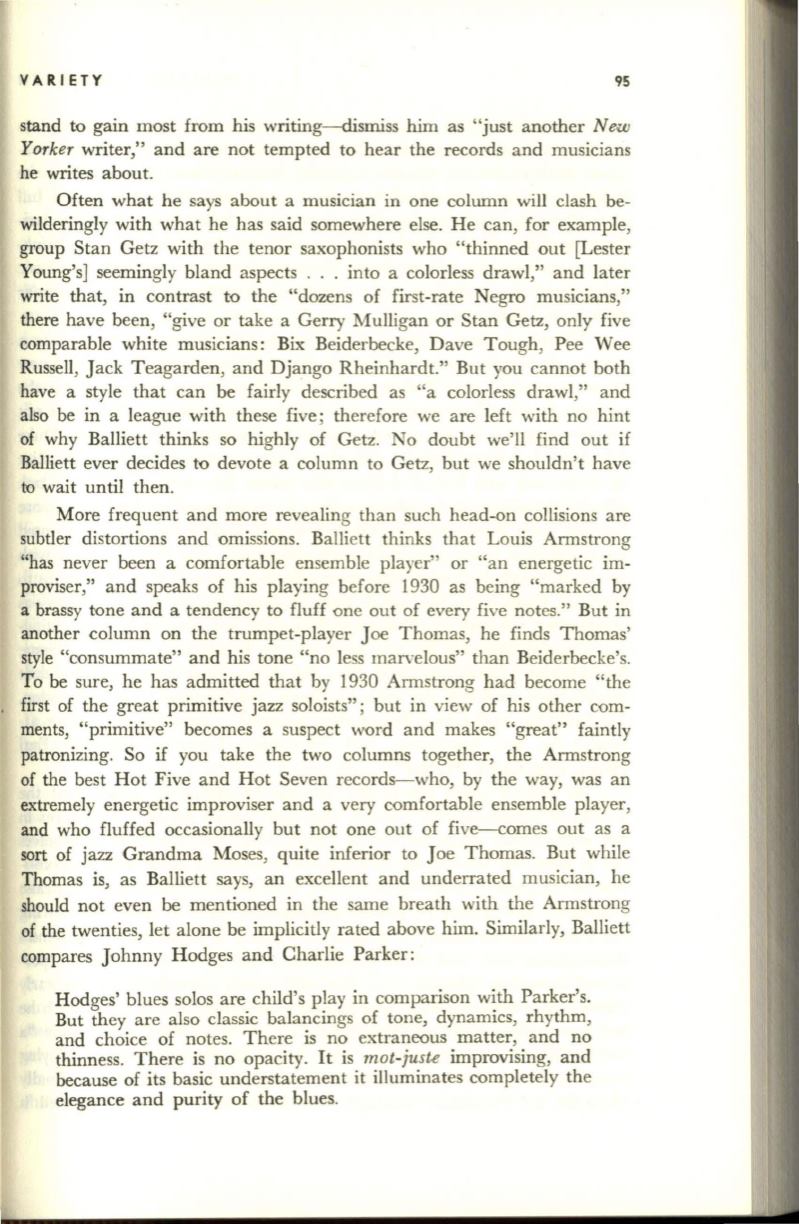
VARIETY
95
stand to gain most from his writing-disrniss him as "just another
New
Yorker
writer," and are not tempted to hear the records and musicians
he writes about.
Often what he says about a musician in one column will clash be–
wilderingly with what he has said somewhere else. He can, for example,
group Stan Getz with the tenor saxophonists who "thinned out [Lester
Young's] seemingly bland aspects ... into a colorless drawl," and later
write that, in contrast to the "dozens of first-rate Negro musicians,"
there have been, "give or take a Gerry Mulligan or Stan Getz, only five
comparable white musicians: Bix Beiderbecke, Dave Tough, Pee Wee
Russell, Jack Teagarden, and Django Rheinhardt." But you cannot both
have a style that can be fairly described as "a colorless drawl," and
also be in a league with these five; therefore we are left with no hint
of why Balliett thinks so highly of Getz. No doubt we'll find out if
Balliett ever decides to devote a column to Getz, but we shouldn't have
to
wait until then.
More frequent and more revealing than such head-on collisions are
subtler distortions and omissions. Balliett thinks that Louis Annstrong
"has never been a comfortable ensemble player" or "an energetic im–
proviser," and speaks of his playing before 1930 as being "marked by
a brassy tone and a tendency to fluff one out of every five notes." But in
another column on the trumpet-player J oe Thomas, he finds Thomas'
style "consummate" and his tone "no less marvelous" than Beiderbecke's.
To be sure, he has admitted that by 1930 Armstrong had become "the
first of the great primitive jazz soloists"; but in view of his other com–
ments, "primitive" becomes a suspect word and makes "great" faintly
patronizing. So if you take the two columns together, the Annstrong
of the best Hot Five and Hot Seven records-who, by the way, was an
extremely energetic improviser and a very comfortable ensemble player,
and who fluffed occasionally but not one out of five-comes out as a
sort of jazz Grandma Moses, quite inferior to Joe Thomas. But while
Thomas is, as Balliett says, an excellent and underrated musician, he
should not even be mentioned in the same breath with the Armstrong
of the twenties, let alone be implicitly rated above him. Similarly, Balliett
compares Johnny Hodges and Charlie Parker:
Hodges' blues solos are child's play in comparison with Parker's.
But they are also classic balancings of tone, dynamics, rhythm,
and choice of notes. There is no extraneous matter, and no
thinness. There is no opacity. It is
mot-juste
improvising, and
because of its basic understatement it illuminates completely the
elegance and purity of the blues.


